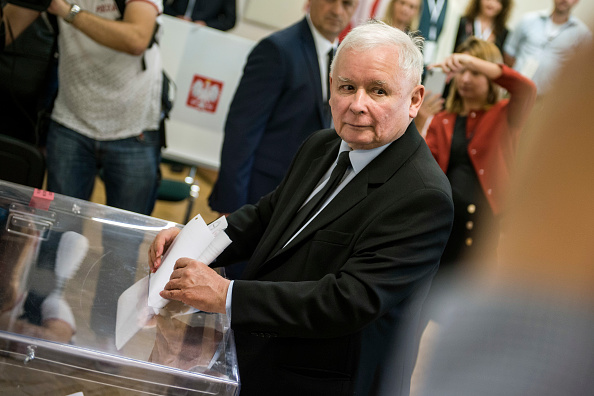Four years after its first electoral sweep, PiS can no longer be regarded as a fluke. Just last week, Polish voters delivered PiS a renewed majority in the parliament’s lower house, the Sejm. This latest victory was not a mistake, and there was little that the opposition could have done to prevent it. In fact, PiS attracted more than two million more voters in 2019 than it did in 2015, taking 235 of the Sejm’s 460 seats.
The right-wing party has a strategy that is working. Since 2015, it has become expert at enticing disadvantaged voters and ginning up fear. The party has doled out promises to retirees, farmers, blue-collar workers, and parents—first of three or more children, then of two, and finally of just one child. In 2017, before the European parliamentary elections, the PiS used the news channel it dominates to sow anti-refugee paranoia. In the lead-up to this year’s polls, it amped up conservative hatred and fear of sexual minorities.
The PiS has coaxed the wave of fear and hatred to new heights. The party has proposed a bill ostensibly meant to curb the “over-sexualizing of children,” but which in fact mirrors a “gay propaganda” law that Russia passed in 2013. The legislation stipulates that teaching basic sexual education to minors is punishable with a five-year prison sentence. Only a softened version of the bill will likely be voted on. But very fact that it has been proposed, as well as its timing, demonstrates that PiS now possesses a well-oiled and aggressive political machine.
And yet, for all the party’s recent success, PiS leaders seem to know that their moment could be an ephemeral one. “We have received much, but we deserved more,” Kaczynski commented when the election results came in. That PiS is not now resting on its laurels is perhaps one more sign of its savvy—or an indication of the tremendous uncertainty ahead for Poland. The country’s political landscape is in flux, and today’s divisions of power could easily be rearranged tomorrow.
A FRACTURED LANDSCAPE
PiS’s majority is more precarious than it first appears. Yes, the party attracted more than two million new votes—but this gain coincides with a general upsurge in voting. In the 2015 election, 15 million Poles cast valid votes. This year, the number reached 18.5 million, accounting for more than 61 percent of the population. Not since the first post-communist election in 1989 had so many Poles come out for a parliamentary vote. Of them, more than 50 percent of them opted for PiS’s centrist or leftist opponents.
As the election’s biggest individual winner, PiS secured a majority in the Sejm—but not a large enough majority to change the constitution or overcome a presidential veto. The latter is not an immediate problem, since the current Polish president, Andrzej Duda, is a faithful PiS member. But his term ends next year, at which point he will face some credible challengers from the center and the left. These are likely to include Donald Tusk, a former centrist prime minister who currently heads the European Council, and several popular young politicians, such as Robert Biedron and Katarzyna Lubnauer. To fulfill populist campaign promises between now and then, the PiS-dominated Sejm will need to raise some taxes or incur new national debts. Such moves will provide Duda’s opponents with easy talking points.
Moreover, PiS now controls only one of Poland’s two national legislative chambers. For four years, the party controlled both houses and was able to push its bills through with little resistance. Now, after a heated fight, PiS lost its majority in the Senate in a series of tight votes and claims just 48 senators, while 52 hail from the opposition or are independent. Only one of the independent senators is likely to side with PiS in crucial votes. The Polish Senate does not have all the powers of its American counterpart, but several crucial posts, including that of national ombud, require the approval of the upper house. The Senate can also delay government proposals through revisions, debates, and filibusters.
The PiS may have handily defeated the old majority party, Civic Platform (PO), but in Poland as elsewhere, new political competitors are on the rise. Small parties did comparatively well in the recent election and have reason for further optimism. A Christian-Democratic, agrarian party known as Polskie Stronnictwo Ludowe (Polish People’s Party) performed well in rural areas, doubling its seats in the lower chamber. A coalition of leftist parties called Zjednoczona Lewica (United Left) won 49 seats—up from no seats at all four years prior. A new extreme-right-wing party, Konfederacja Wolnosc i Niepodleglosc (Confederation for Freedom and Independence), won 11. Liberal and leftist women joined the Polish parliament in record numbers; so did young activists, who vaulted to the top of establishment-heavy voting lists across parties.
The rise of these new forces could quickly render the strategy that PiS has honed obsolete. The public to which PiS has attuned its appeal is one divided between social conservatives and free-market liberals. But that landscape is changing as PO fades into the background and other opposition groups emerge with different priorities. These small parties attack PiS’s policies from new angles and offer social and economic worldviews that cannot be classified neatly as liberal.
The Confederation has already fractured the right-wing vote and threatens to fragment it further. Led by old conservatives together with young libertarians, the group offers an explosive cocktail of radicalisms: monarchism, minarchism, anti-Semitism, queer-phobia, and misogyny. PiS may need the Confederation’s support in Sejm, where the radicals could use their leverage to press the PiS’s proposals to even greater extremes. The left-of-center parties, meanwhile, are drawing the economically disadvantaged away from PiS.

GENERATIONAL PRESSURES
None of Poland’s alternative parties is likely to take over government on its own. But together the groups are helping to unravel the two-party system that had begun to take shape after 2007. During the nineties, Poland had several governments formed from coalitions of small parties. The coalitions were often querulous and messy. But at a time of polarization, Polish voters may well demand a return to this slow-moving, compromise-based approach.
At the moment, with PiS in control of both Sejm and the presidency, such a shift feels far off. But generational change brings it nearer. Polish parties are refashioning themselves as fresh faces appear at the polls. In the past, leftists were often politically handicapped by the accusations that they were former pro-Soviet communists. Today’s young leftist leaders have shed such historical associations, even despite the best efforts of PiS and the church to impute them. For models, young leftists look not to Russia but to the EU and Scandinavia. Even PO has a share of young, dynamic leaders, to whom its more complacent senior establishment will soon have to start devolving power.
The populist right is every bit as vulnerable to generational dynamics as the center and left. The success of the Confederation’s young libertarians suggests as much. So does the tension within PiS between the 70-year-old Kaczynski and some of his deputies who are some 20 years younger, including Zbigniew Ziobro and Jaroslaw Gowin. Anonymous PiS politicians have suggested to reporters that these younger leaders are jostling for greater influence, and a divisive fight for the party’s leadership is close at hand.
Poland’s political parties are addressing themselves to a revivified public. The past few years have seen a surge of protest on all sides: for and against abortion, LGBTQ rights, judicial independence, and more. This past week, Poles at home and abroad cast a record number of votes. Such a public can be counted on to make strong demands and ask hard questions. The moment’s uncertainty seems to trouble PO and PiS—and to elate their competitors to the left and the right. Four years from now, the tactics that will win Poland’s next parliament are unlikely to look anything like the ones that carried the election last week.
This article was originally published on ForeignAffairs.com.








